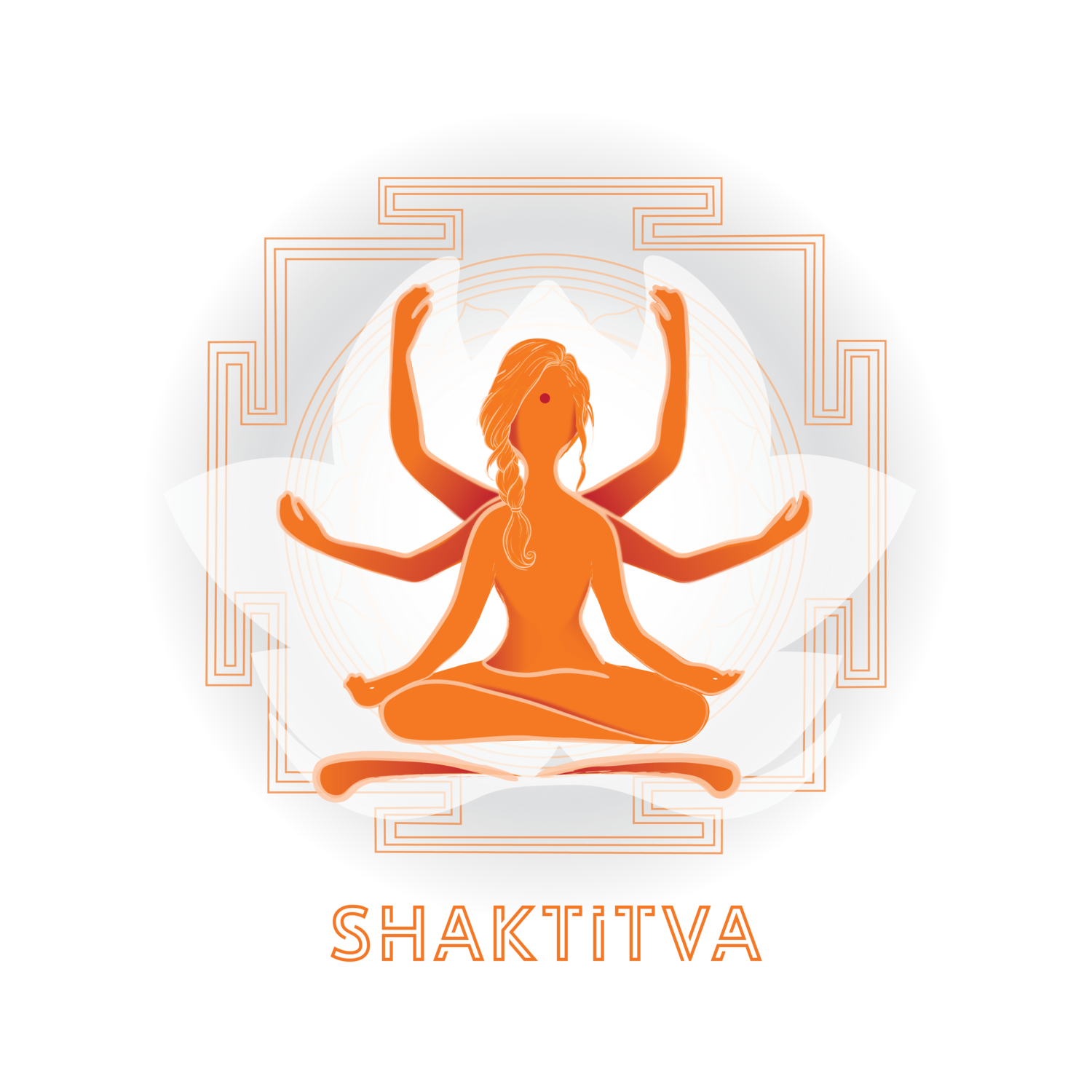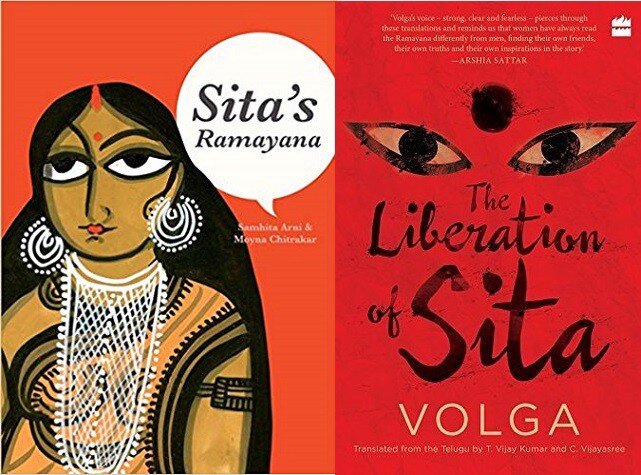“The Liberation of Sita” is an ignorant “feminist” re-telling of the story of Sita, by Telugu writer Volga. Sadly, due to ignorance of native understanding, many such colonized “narratives” abound in contemporary writing.
In this era of post-modern, post-colonial, post-everything scholarship, we observe that many contemporary scholars, both Indian and Western have been extremely fascinated by the Ramayana and specifically Mata Sita. For some, Mata Sita epitomizes the ultimate sacrifice, for others, she becomes the golden albatross they can hang around Bhagwan Rama’s neck. Some westernized feminists all see her as an embodiment of patriarchal oppression, while others try to fashion her into warrior queens and some even make ignorant and quite exasperating attempts at “liberating” her. In this era where only formalized, westernized knowledge is considered worthy and therefore, Hindus who are losing touch with their mother tongues as well as Sanskrit, have completely lost touch with the native, Indic understanding of Ramāyana. It is our hope that this article should make it abundantly clear, how these “readings”, “re-tellings” and “interpretations” are misguided at best, and mischievous at worst.
One common perception of “religion”, characteristic of this contemporary era, is that all religions are about Gods, rituals, symbols, images, dogmas, festivals, saints, shrines and so on. After all, all cultures in the world believe in existence of an entity/entities that lead to creation of this vast arrangement called Universe and those entities are considered as the cause of everything one sees or perceives. Therefore, at the end of the day, all religions are the same. This too, perpetuates a situation where only the secular understanding of Ramayana is encouraged, which in turn requires studying it like a story with characters, but without its true meaning (Bhaava). Today, on this auspicious Diwali day, we shall attempt to study, Ma Sita’s true nature as interpreted in Maharishi Valmiki’s Ramayana.
What is God?
The Vaidika people, who consider Veda as highest authority put forth an interesting question. They wondered, that if Īshwara (ईश्वर) created everything, it should mean that he also created Jñana (ज्ञान). If he created Jñana, was he without Jñana, i.e. without knowledge, and therefore, ignorant before its creation? If Īshwara was ignorant, how could he create anything?
Therefore, the only possible solution to this paradox is to conclude that Jñana is not created by anybody, therefore, it is Apaurusheya (अपौरुषेय) . This means that Jñana (knowledge) can neither be created nor destroyed.
Our sages also address this through the concepts of ātman (self) and brahma in Upanishads. The entirety of creation is an epiphenomenon due to existence of brahma.
ज्ञान स्वरूपमखिलं जगदेतबुद्धयः।
अर्थ स्वरूपं पश्यन्तो भ्राम्यन्ते मोहसम्प्लवे।।
Vishnu Purana- 1.4.40।।
(All that exists is nothing but Jñana, ignorant sees the diversity due to his attachments.)
All rules, rituals and actions (karma) prescribed by Shastras are tools to know and understand the ultimate reality. If your karma is not in harmony with this Goal of the Vedas, its mere labour. Thus, Manu in the conclusion of his Dharma Shastra says-
सर्वेषामपि चैतेषां शुभानामिह कर्मणाम् ।
किं चित्श्रेयस्करतरं कर्मोक्तं पुरुषं प्रति ॥12.84॥
सर्वेषामपि चैतेषामात्मज्ञानं परं स्मृतम् ।
तद् ह्यग्र्यं सर्वविद्यानां प्राप्यते ह्यमृतं ततः ॥12.85।“From among all these good acts, is there any one act which has been described as more efficacious in securing to man his Highest Good?”—(84)
Of all these, Knowledge of the Self has been declared to be the most efficacious; since it is the best of all sciences, as Immortality is attained by its means. (85)
Thus, comparing the Vaidika Dharma with other religions, particularly, Abrahamic religions is a fallacious argument. The God, Īshwara for Vaidikas, is not an extra-terrestrial entity seated in heaven, but in fact, it is their own self. It is this SELF that has been glorified as Shiva, Vishnu, Devi, Indra, by various sages, in various texts.
"अयं स भगवानीश: स्वयंज्योति: सनातन:।
अस्माद्धि जायते विश्वमत्रैव प्रविलीयते॥
Suta Samhita 2.10.35।।
(This ātman is bhagwān, īshwar, immortal, self-illuminated. From it, the world arises, in it, the world is dissolved)
"अयं ब्रह्मा शिवो विष्णुरयमिन्द्र: प्रजापति।
अयं वायुरयं चाग्निरयं सर्वाश्च देवता:॥"
Suta Samhita 2.10.36
(It is Brahma, Shiva, Vishnu, Indra and Prajāpati. It is Vāyu, Agni and all the devtās.)
Understanding the relationship between Brahma and Māyā
The energy or power of Brahma is called Maya. Brahma and Maya are like Sun and its Rays. Rays exist because there is a Sun. Similarly, Maya exists because there is Brahma. It is a worthless exercise to understand them as separate entities.
परास्य शक्तिर्विविधैव श्रूयते स्वाभाविकी ज्ञानबलक्रिया च ।।
(Shvetashvatara Upanishad- 6.8)
It had diverse inherent energies of knowledge, force and action.
Just as Sunlight causes illusion of water in sky, same way all states of existence are there due to Brahma and Maya -
तेजो वारिमृदां यथा विनिमयो यत्र त्रिसर्गो मृषा-
Bhagvatam-1.1.1.
(In reality, this atman does nothing. It simply exists, and everything else is perceived due to its existence.)
It does nothing-
साक्षी चेता केवलो निर्गुणश्च
Shvetashvatara Upanishad – 6.11.
But its mere existence induces Maya, which is nothing but its energy. Energy enough to create thousands of universes.
And in fact, there is no difference between the nature of the Jīva and Īshwara.
मायासंबन्धतश्चेशो जीवोऽविद्यावशस्तथा ।।
Kath Rudra Upanishad-39।।
(In relation with Maya, atman is Īshwara, In relation with Avidya its Jīva).
मायाविद्ये विहायैव उपाधी परजीवयोः ।
अखण्डं सच्चिदानन्दं परं ब्रह्म विलक्ष्यते ॥ Adhyatma Upanishad- 32।।
(On rising above Māyā and Avidyā, Reality is known).
Who are Rāma and Sīta in Mahāṛishi Vālmikī’s Ramāyana?
The same atman has been glorified as Rama by Maharishi Valmiki in is Ramayana, at the very beginning of which, he says-
वेद वेद्ये परे पुंसि जाते दशरथात्मजे ।
वेदःप्रचेतसादासीद् साक्षाद् रामायणात्मना।।Valmikī Ramayana -1.1.1।।
(The Supreme being who is known through Vedas, descended as son of Dashrath, Vedas were rendered in form of Ramayana by son of Pracheta Valmiki.)
वेदोपबृंहणार्थाय तावग्राहयत प्रभुः ||
1.4.6- Valmiki Ramayana
(epic Ramayana is composed only to reinforce the import of Veda)
This shloka of Sundarkand is clear indicative of Divinity of Rama
सर्वान् लोकान् सुसम्हृत्य सभूतान् सचराचरान् ||
पुनरेव तथा स्रष्टुम् शक्तो रामो महायशाः।।
Valmiki Ramayana- 5.51. 39
(Illustrious Rama can put an end to whole creation along with its creatures, and can again create them, such is his potential.)
Valmiki Ramayana is full of such shlokas, for anyone who would attempt to see it.
Ancient seers were wise enough to understand the difficulties regarding knowing the real nature of the self. Thus, they described the reality in a manner that would allow us to perceive reality through each of our faculties, our mind and our sense.
Without understanding the existence, one cannot understand the reason of the existence. Therefore, without understanding the how Maya works, one cannot understand the maya-pati Bhagwan.
In other words without knowing the Goddess (mahamaya), one cannot understand the God. This is the beauty of the Vaidika Dharma. If you want to know Rama, you have to know Sita.
Thus Maharishi Valmiki named the Saga of Rama as
सीताया: चरितं महत्- 1.4.7- The Sublime Legend of Sita.
अप्रमेयं हि तत् तेजो यस्य सा जनकात्मजा- Valmiki Ramayana- 3.37.18
That resplendence (Rama) is not measurable which/who has daughter of Janaka-Sita.
In fact, Mata Sita herself says:
अनन्या राघवेणाहं भास्करेण प्रभा यथा।
Valmiki Ramayana- 5.21.16
(I am inseparable from Rāghava, like radiance from sun)
She continues,
अहमौपयिकी भार्या तस्यैव वसुधापतेः।।5.21.17।।
व्रतस्नातस्य विप्रस्य विद्येव विदितात्मनः।
"I, alone, am the righteous wife of the Lord of the Earth. Like the knowledge of the Vedas which rightfully belongs to a wise one who has realised the self after having had his graduation bath, having observed the righteous vows during the period of his study.
This is not surprising. Mahadev Shiva reveals this Secret to Devi Parvati in the Adhyatma Ramayana, which is part of Brahmanda Purana. Hanuman-Sita dialogue is narrated by Shiva. Hanuman enquired about Rama and Sita replied-
रामं विद्धी परं ब्रह्म सच्चिदानंद अद्वयं।
सर्वोपाधिविनिर्मुक्तं सत्तामात्रमगोचरं।। 1.32।।
Know Rama as non-dual Brahm, free from all attributes about which only this much is known that ‘it is’
तत्सान्निध्यान्मया सृष्टं तस्मिन्नारोप्यतेऽबुधैः । अयोध्यानगरे जन्म रघुवंशेऽतिनिर्मले ।।३५ ।।विश्वामित्रसहायत्वं मखसंरक्षणं ततः । अहल्याशापशमनं चापभङ्गो महेशितुः ॥ ३६ ॥मत्पाणिग्रहणं पश्चाद्भार्गवस्य मदक्षयः । अयोध्यानगरे वासो मया द्वादशवार्षिकः।। ३७ ॥ दण्डकारण्यगमनं विराधवध एव च । मायामारीचमरणं मायासीताहृतिस्तथा ॥ ३८॥ जटायुषोमोक्षलाभः कबन्धस्य तथैव च । शबर्याः पूजनं पश्चात्सुग्रीवेण समागमः ॥ ३९॥ वालिनश्च वधः पश्चात्सीतान्वेषणमेव च । सेतुबन्धश्च जलधौ लङ्कायाश्च निरोधनम् ॥ ४०॥ रावणस्य वधो युद्धेसपुत्रस्य दुरात्मनः । विभीषणे राज्यदानं पुष्पकेण मया सह ॥ ४१॥ अयोध्यागमनं पश्चाद्राज्ये रामाभिषेचनम् । एवमादीनि कर्माणि मयैवाचरितान्यपि आरोपयन्तिरामेऽस्मिन्निर्विकारेऽखिलात्मनि ॥ ४२॥ रामो न गच्छति न तिष्ठति नानुशोचत्याकाङ्क्षते त्यजति नो न करोति किञ्चित् । आनन्दमूर्तिरचलः परिणामहीनो मायागुणाननुगतो हि तथा विभाति ॥४३
In these verses Mata Sita narrates the Ramayana and reveals to Hanuman that from the moment of Rāma’s appearance before Kaushalya to RajyAbhisheka of Rama, everything has been done by Mata Sita herself.
Rāma does nothing –
रामो न गच्छति न तिष्ठति नानुशोचत्याकाङ्क्षते त्यजति नो न करोति किञ्चित् ।
आनन्दमूर्तिरचलः परिणामहीनो मायागुणाननुगतो हि तथा विभाति ॥ 43।।
Rama doesn’t go, doesn’t stay, doesn’t mourn, doesn’t long, doesn’t shun, doesn’t do anything. Rama is bliss, unperturbed, unmoved, unchanged.
Thus its established Rama is atman and Sita, his Shakti. Thus, the lovable Saguna Bhagwan is available to us via the virtue of Bhagwati only. From an atom to Virat Hiranyagarbha, everything is Sita - The Goddess. This creation, its innumerable creations, this profusion of the galaxies, everything is Mother Goddess. From the vantage point of creation, Sita and Rama are two entities and from the vantage point of non-duality, They are One, like flame and its heat.
त्वं विष्णुर्जानकी लक्ष्मीः शिवस्त्वं जानकी शिवा । ब्रह्मा त्वं जानकी वाणी सूर्यस्त्वं जानकी प्रभा ॥
Ayodhya kand. Adhyatma Ramayana।।
Rama, you are Vishnu, and Janaki (Sita) is Laxmi. You are Shiva and Janaki too, is Shiva. You are Brahma and Janaki is Vaani, You are Surya and Jaanaki is radiance.
Goswami Tulsidas too, agrees -
श्रुति सेतु पालक राम तुम्ह जगदीस माया जानकी।
जो सृजति जगु पालति हरति रूख पाइ कृपानिधान की।।O Rama, the protector of Shruti, you are the Īshwara and Janakī is Maya, who creates, sustains and destroys because of you.
This is the true essence of “श्रीयते हरिणापि या सा श्री”- the one who is worshipped or served by Hari/Bhagwan is Shri .
Thus, the Shrī in Jai Shrī Rama, is Mata Sita as Shri Devi herself, the Supreme Mother, the Divine Feminine, who has been extolled by Vedas and Puranas.
One must have pity at the misfortune of those who see the glorious proclamation of Jai Shrī Rama as a “masculine” or “patriarchal” war cry. We have even come across ignorant narratives of how Mata Sita was dropped from colloquial “Jai Siya Ram” to make it patriarchal “Jai Shri Rama”. For after all, it is they, who are truly ignorant of the Glory of the Divine Mother who pervades all creation as Shakti. It is fundamentally impossible to drop Mahamaya Devi Sita from anything pertaining to Rama, for he cannot be understood without her. It is therefore, also our ignorance to assume that Ma Sita was “victimized” or “oppressed”.
This Diwali, let us vanquish ignorance with the knowledge that Ma Sita, the Mother of all creation, needs no “advocates”. She is the Divine Feminine, the Shakti, the reason of all existence and inseparable from our Glorious Bhagwan Rama.
Let us proudly proclaim:
Jai Shri Rama!
about the author
Aditya Sharma
Aditya is currently pursuing BBA LLB and is an avid reader of Vaidik literature. He is also an occasional poet. You can follow him on Twitter @aadii009






